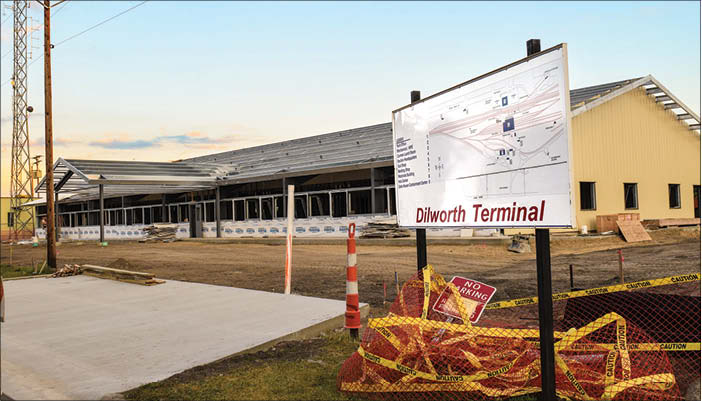A new roofline is rising up at the BNSF Terminal in Dilworth. Construction crews are midway through the process of erecting a new office building on the railroad’s 500-acre site on the south side of town.
The new building – expected to be completed late this year – is being built directly west of the facility that currently houses the railroad’s administrative staff, operations and locker rooms for the crews that work out of the base. The larger facility going up on Second Avenue Southwest will also include conference space to accommodate training and other meetings, according to community affairs spokesperson Amy McBeth of Minneapolis. The project was reported earlier this year to total $2.3 million.
Although the railroad now known as the Burlington Northern Santa Fe has been the core of Dilworth’s economy for more than 110 years, the corporation generally maintains a low profile in the community. Nevertheless, its impact is enormous. Some 300 employees work out of the local headquarters, says Amy, with another 300 using the terminal from other locations.
It’s the largest BNSF facility in Minnesota and North Dakota west of the Twin Cities – a crew change location where cars are switched and can be repaired. Along with the advanced technology that today guides almost every aspect of its operations, the local site includes an automobile facility where dealers connect with vehicles that have arrived by rail. It also hosts extensive intermodal transfer facilities in which trailers and containers move between the rails and the public roadways.
Dilworth owes its whole story to the railroad, says historian Mark Peihl, the Clay County Historical and Cultural Society’s archivist. The Northern Pacific Railway reached Moorhead from Duluth in 1871. Twelve years later, the railroad established a minor railroad siding beside a grain elevator four miles east of the Red River. It was named for Joseph Dilworth, a coffee importer who served on the NP’s board of directors.
Steam locomotives needed regular inspection, refueling and refitting, Mark points out, so division headquarters were spaced every 100 miles or so along the line. The next point west of Staples, Minn., was in Fargo, west of modern University Drive along what’s now Main Avenue. The site was too cramped to accommodate the booming railroad for long, however. In 1906 the NP moved the whole thing to Dilworth, roundhouse, car repair shop, offices and all.
Many employees lived in Fargo and Moorhead, then a 45-minute commute from the new terminal. The railroad established a townsite in 1906. “Starting in 1907, businesses and homes popped up in Dilworth like mushrooms,” Mark wrote in the CCHS journal in Summer 2007, when the city was celebrating its centennial. “The village grew from practically zero in mid-1907 to nearly 500 by Spring 1910.”
In the 1930s, an estimated 90 percent of Dilworth’s employed population worked for the Northern Pacific railroad. That faded, though, as labor-intensive steam locomotives were phased out. By 1958, when the last was sidelined, just 50 percent worked the line. A series of mergers consolidated the railroad with other lines, starting in 1970, when it joined with the Great Northern and two other regional lines. Burlington Northern purchased the Atchison, Topeka and Santa Fe on the last day of 1995. It’s now owned by Berkshire Hathaway, the firm controlled by investor Warren Buffett. The corporation employs 2,300 Minnesotans with a combined payroll of $170 million.
BNSF publications report the railway moves 2.1 million carloads of freight through Minnesota annually. Its $2.3 million upgrade this year in Dilworth is part of an overall program of $85 million to be spent in Minnesota this year, much of it on track maintenance and upgrades. Amy points to an important aspect of its investment: “All of BNSF’s facilities and maintenance are privately funded, rather than at the expense of the American taxpayers.”



